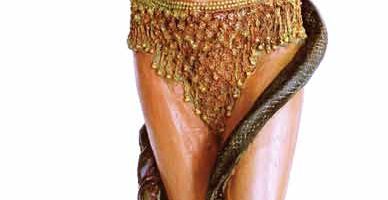
Sex & Judaism

“Eve” by Audrey Flack
A middle-aged woman dropped her pants nearby. Then everyone else joined her. We weren’t supposed to be looking at one another; we were supposed to focus on our own “nest,” a small setup where a “stroker” and a “strokee” intertwined bodies for the practice. The women lay on the ground bottomless, legs spread, while their partners, usually and intentionally male, sat upright. Each draped a clothed leg across his partner’s reclining body, in preparation for “OM” — Orgasm Meditation.
This was all happening in the Scottish Rite Temple in Oakland, California, part of the action at a weekend-long orgasm conference last April. In the palace-like building were more than 700 people poised to listen to Nicole Daedone, founder of Orgasm Meditation, talk about pleasure and consciousness. (The name is reminiscent of 1970’s TM — Transcendental Meditation; this time sexuality is included.) Participants ranged in age from their early twenties to late eighties, of all backgrounds, all shapes and sizes. The women and the men had arrived to get more in touch with themselves, some through actual touching, some through being touched, while others hoped to learn to be better lovers — perhaps one and the same. Nowadays, women tend to use more and more of the technology that is available – sex toys that anyone can get online from stores like Boinkology. They were there for the information about sex, or for the experience, or to undo years of repression.
I was there as an observer-participant, as the anthropologists put it. In the orgasm meditation room, where we were allowed, every hour on the hour throughout the weekend, to practice, it was loud. Women began gasping, then moaning, as their perched partners used the explicit two-handed clitoral stroking technique offered by Nicole Daedone’s intricate orgasm meditation practice, bringing the women to peak pleasure states. Daedone, a New York Times-reviewed TEDx speaker who once wanted to be a nun, has instead turned into an orgasm guru/shamanic businesswoman queen. She was the weekend’s unabashed leader. “This is not about tearing down old structures,” she preached, “but about building new structures that make the old ones obsolete.”
The instructions to participants included boundaries around touch and technique, and also the imperative to “stay present,” to feel the sensation of hand on clitoris, clitoris on hand. The men — some boyfriends, husbands or friends, others partners organically selected by asking “will you OM with me?” on the spot — were expected to tune into the feelings and changes happening in the women, to watch their partners’ genitals shift and change with deeper arousal. They were supposed to learn about their own peaks and valleys from witnessing and engaging the female pleasure center. Two by two, en “nest,” we were being coached, pushed, encouraged to come. A man leading this particular session walked the perimeter of the room and announced, “I like how it sounds in here.”
OMX is an arm of the rapidly spreading Orgasm Meditation movement. A staff of trained sex coaches and workshop leaders, dressed in “Powered by Orgasm” or “Orgasm Expert” t-shirts, ran participants in the three-day conference through a range of lectures on sex, sexuality, and the ownership of pleasure, all punctuated by the option to “OM” every hour, on the hour.
Upstairs, in a massive auditorium, throngs of people were listening to speakers like writer Neil Strauss, actresses Gabrielle Anwar and Catherine Oxxenberg and transcendental sex expert Jenny Wade. Downstairs, people were spreading their legs or stroking their partners.
The Scottish Rite Temple where we were gathered for all of this orgasm business just happens to be where my synagogue, Kehillah, hosts Yom Kippur services. Last September at Kol Nidre, I had occupied in a front-row balcony seat in that auditorium with my aunt and uncle on one side and two friends from a Jewish Renewal retreat on the other. And at the Friday night kickoff for the Orgasm Meditation weekend, a staff member led me to that front-row balcony again — weirdly, to the very same seat I’d occupied at Yom Kippur.
This Friday night I had actually vetoed services at Kehillah to come to the conference. When else would I be invited to an Orgasm Meditation conference? Barrie Cole, a Jewish woman from Chicago who is a poet, opened the proceedings. “This is the best bat mitzvah redo ever,” she exclaimed, throwing her arms in the air. “I feel reborn, re bat-mitzvahed. I get to have one again and again in 15 minute segments — and this is growing me up for real this time,” she said.
Where Judaism had fallen short for her, Cole had found Orgasm Meditation — a free-loving solution to what she said she had found to be a stale and frigid synagogue past. This was her new religion, in line with Daedone’s urging to build new structures that “make the old ones obsolete.”
Judaism is a job, though. It requires searching and questioning. When I heard Barrie Cole lament the Jewish world and her dead-end bat mitzvah, I wasn’t sure she had done her work. What would I have done if I had said, yes, my father’s Judaism is my Judaism, and called it a day? What finding my own Judaism was about, really, was about blending sex and pleasure and feminism into a Judaism that, I learned with time, already contained those ingredients. I just had to do my homework.
In 2010 I was the author of AskYourYenta.com, an online advice column that eventually was syndicated by the L.A. Jewish Journal and supposedly offered Jewish answers to secular problems. In answering people’s sex, body, and dating questions, I realized I knew nothing of Jewish sex, per se, about Torah and what it said about bodies, intimacy, love and relationships. It was sex writing that brought me to an Orthodox yeshiva in Israel.
I had left Conservative Judaism in my early 20s. Judaism and God and synagogue felt like a cold, dark place where I was “supposed to know more,” where spirituality was dead, where everything was about following the rules. But for me, Judaism was also warm. It contained family, tradition, community, grandparents, memory and food. It wasn’t something I was going to leave by the wayside. It was just something I was going to have to figure out.
I began to find a different Judaism: A Reconstructionist woman-led service on Martha’s Vineyard. The GLBT synagogue at the JCC in downtown Washington, D.C., where the people led the rabbi-less services. The Jewish study-session services held in a church library in Santa Fe, New Mexico.
In Boulder, Colorado, I found Renewal Judaism, which embraces the divine feminine and has a throwback neo-Chasidic style that blends in modern ideals of inclusion. I studied with Reb Zalman Schachter-Shalomi, the powerfully influential, recently deceased founder of the movement.
Over the years, I visited more than 30 Jewish communities across the country and extracted for myself a Judaism that felt vital, real, and mine, discarding the pieces that no longer served me.
I studied in Israel for a year, at Pardes, a Modern Orthodox yeshiva, and I trusted them to fill in the blanks. It was progressive insofar as it daringly brought men and women, queer, straight and otherwise into one learning space. I read pasuk by pasuk — line by line — the book of Genesis. I learned the basics of Talmud, read Rashi, Ramban and the Sefat Emet and learned about the Baal Shem Tov. I learned the prayers I always felt ashamed for not knowing and linked into a tight knit kosher collective of young adults striving to be better people and better Jews.
I overheard the advanced Talmud students debating bodily fluids, the color and texture of women’s discharge — all standard rabbinic studies. I listened in Torah class to the power of beauty between Sarah and the kings of Egypt, the possibility of sexual abuse between Noah and his son, or about the slut-shaming of Hagar, sent off alone with her child. I learned that the rabbis never shied away from discussing sex. Who knew that Moses’ wife circumcised their son with a rock against her husband’s thigh, that female pleasure was paramount and sanctioned? Jewish sources addressed sex and alcohol, female-endorsed consent, and the number of days a man is allowed to be away from his wife’s body.
I learned that if a wife isn’t sexually pleased after six months, she is entitled to a divorce. I learned that the rabbis spoke at length about where intersex people should pray in a room divided by one’s sex organ. Judaism, it turns out, is full of sexual wisdom and gender complexity, full of lessons that helped to inform my secular American life. But it required a good, discerning translator.
While at Pardes I started teaching sex workshops out of my Jerusalem apartment. The ten or so women who would gather, would use biblical passages to engage our American — and mostly secular — sexual dilemmas. I served cookies, we burned candles, and everyone talked about sex and God and Judaism and the tensions between. I found what I was looking for.
On the third day of the OMX conference, one of the keynote speakers was Jewish feminist writer Naomi Wolf, author of The Beauty Myth and, more recently, of Vagina. She took the stage. “We live in a society that spent 5,000 years damaging the goddess,” she told the crowd, walking across the stage like she owned it. “We are getting sick for repressing and denying the divine feminine,” she said. Who knew that her secret obsession was the goddess? I was with her. But then she lost me.
She talked about how Judaism punished female sexuality with stoning to death, about the death of the divine feminine as well. She was right that in Judaism there is also a mess of misogyny. I agreed with her critique of that. But to cite the worst parts of Judaism without raising its complexity, its nuance, its attention to minute detail? I felt robbed. And they weren’t taking questions.
I approached Naomi Wolf afterward. I told her my thoughts on the death of the goddess. I told her that in Judaism the divine feminine is alive, it is ever-present, it just isn’t always so simple to recognize. I told her I thought what she’d said was dangerous, that the divine feminine is only submerged, not gone. She seemed to actually listen to me, though I had expected a fight. After a pause, she answered me. “You are right. The divine feminine is there, but you have to do the work to recover it.”
I accept the challenge to raise the “divine feminine” in Judaism. I want the Orgasm Conference and Torah. After the OMX conference I went to “Glitter Kehillah,” a GLBTQ Shabbat dinner in Oakland. We were all eating challah and talking about sex, questioning ritual and queerness and transmission. Because for us, that was what Judaism had become — the bad bat or bar mitzvah was only the beginning, a launching point to a richer, complex Judaism that welcomes our bodies, our sex lives, and the divine feminine everywhere.
Merissa Nathan Gerson [www.MerissaNathanGerson.com] has written about sex, culture and religion for Refinery29, Salon.com, The Atlantic, Tablet, Elle.com and The Jewish Daily Forward. She holds an M.A. in Jewish Studies with a focus on Sex and Sexuality and Intergenerational Trauma and is a Program Associate at Seven Wells: Sex Education Redrawn.


